ECON6000: Economic Principles & Decision Making - Module 1 Assessment
VerifiedAdded on 2023/06/11
|9
|1258
|411
Homework Assignment
AI Summary
This assignment delves into the application of economic principles to business decision-making, specifically focusing on supply and demand analysis and production possibilities. Problem A utilizes the Production Possibility Frontier (PPF) to illustrate efficient resource allocation for Schmeckt Gut's product line, analyzing the impact of increased demand on production capacity. It emphasizes that increasing the production of both goods requires enhancing production capacity through resource discovery, technological advancements, or specialization. Problem B focuses on market equilibrium, determining the equilibrium price and quantity for energy bars using given demand and supply functions. It further examines the effects of a price increase on demand and supply, explaining the inverse relationship between price and demand through income and substitution effects, and the positive relationship between price and supply due to increased profitability. The solution demonstrates a clear understanding of microeconomic concepts and their practical applications in business scenarios.
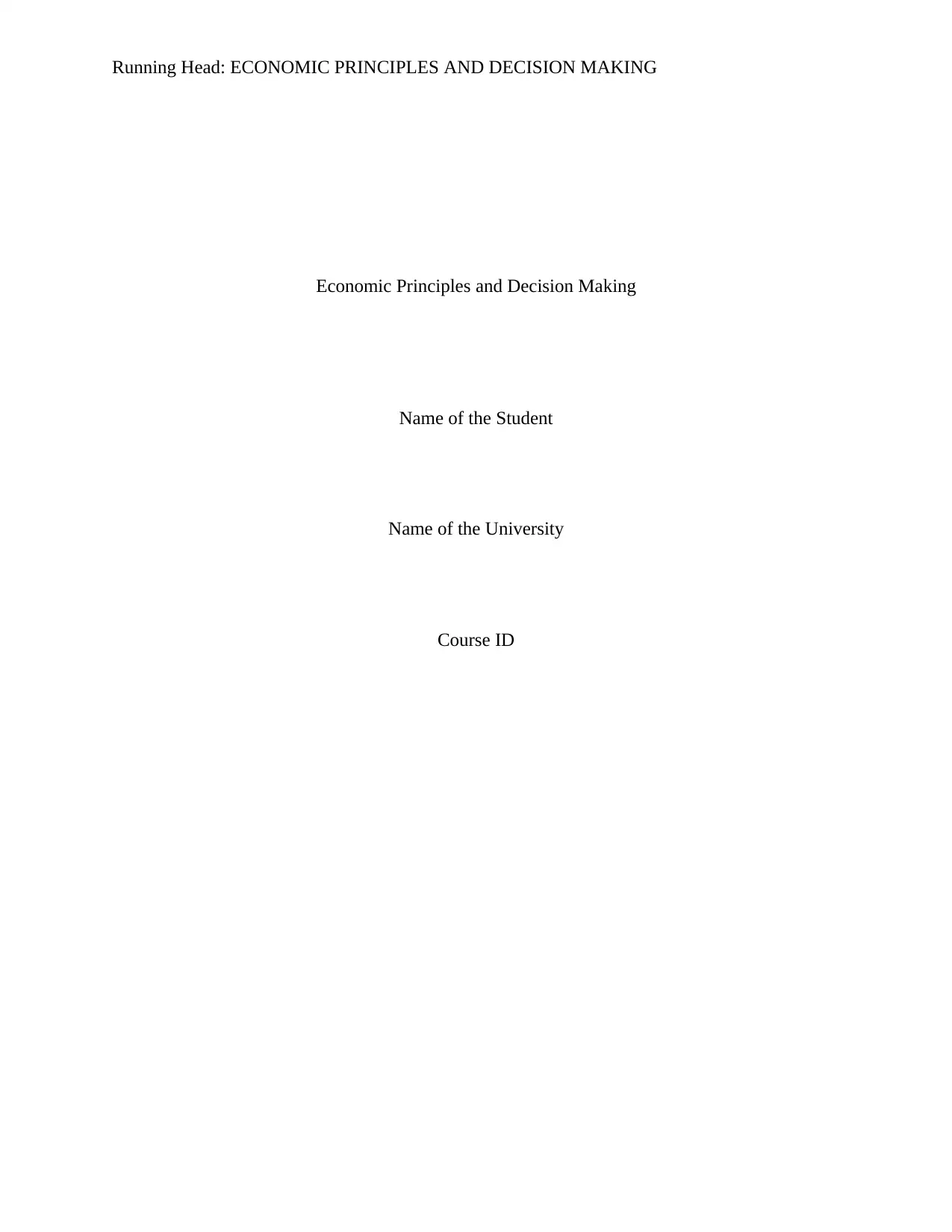
Running Head: ECONOMIC PRINCIPLES AND DECISION MAKING
Economic Principles and Decision Making
Name of the Student
Name of the University
Course ID
Economic Principles and Decision Making
Name of the Student
Name of the University
Course ID
Paraphrase This Document
Need a fresh take? Get an instant paraphrase of this document with our AI Paraphraser
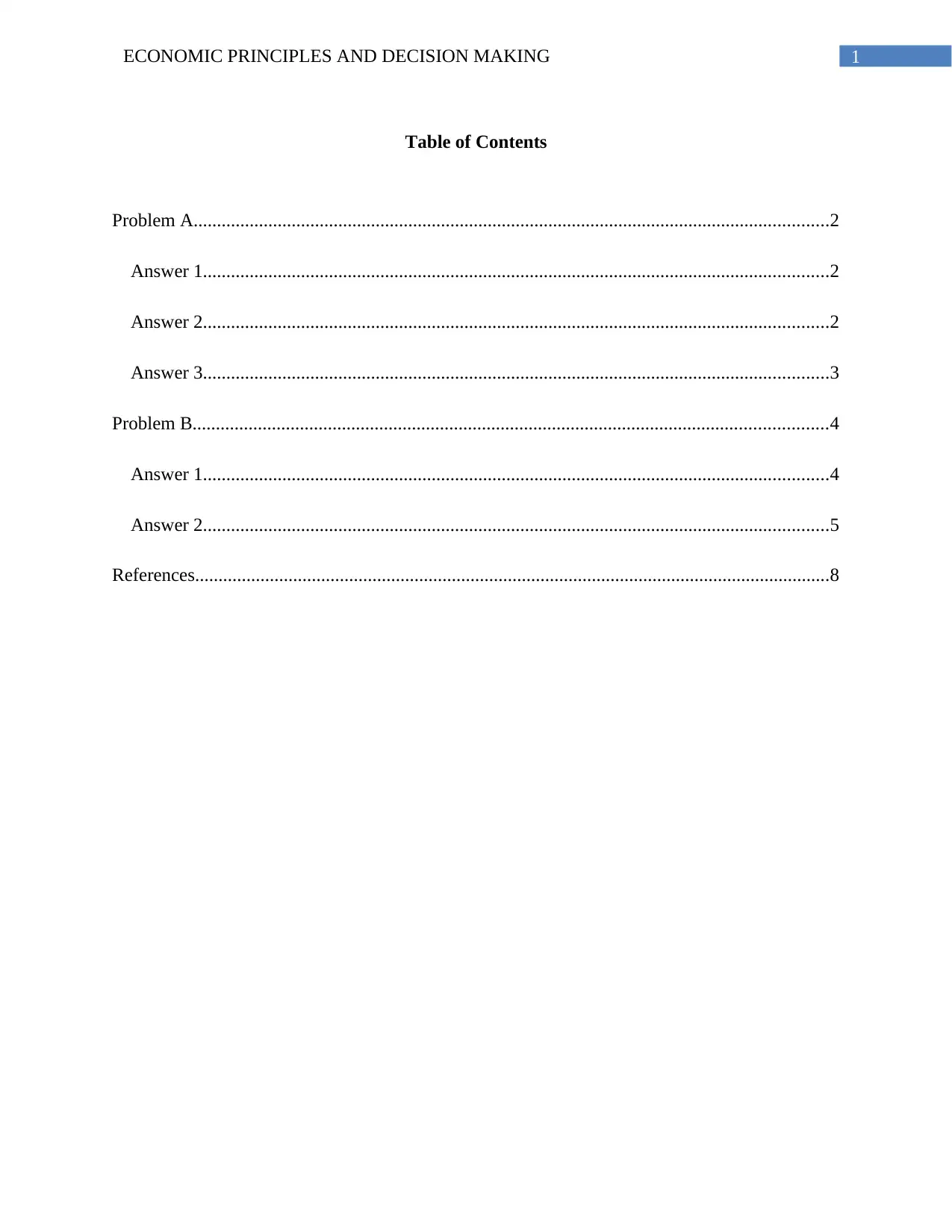
1ECONOMIC PRINCIPLES AND DECISION MAKING
Table of Contents
Problem A........................................................................................................................................2
Answer 1......................................................................................................................................2
Answer 2......................................................................................................................................2
Answer 3......................................................................................................................................3
Problem B........................................................................................................................................4
Answer 1......................................................................................................................................4
Answer 2......................................................................................................................................5
References........................................................................................................................................8
Table of Contents
Problem A........................................................................................................................................2
Answer 1......................................................................................................................................2
Answer 2......................................................................................................................................2
Answer 3......................................................................................................................................3
Problem B........................................................................................................................................4
Answer 1......................................................................................................................................4
Answer 2......................................................................................................................................5
References........................................................................................................................................8
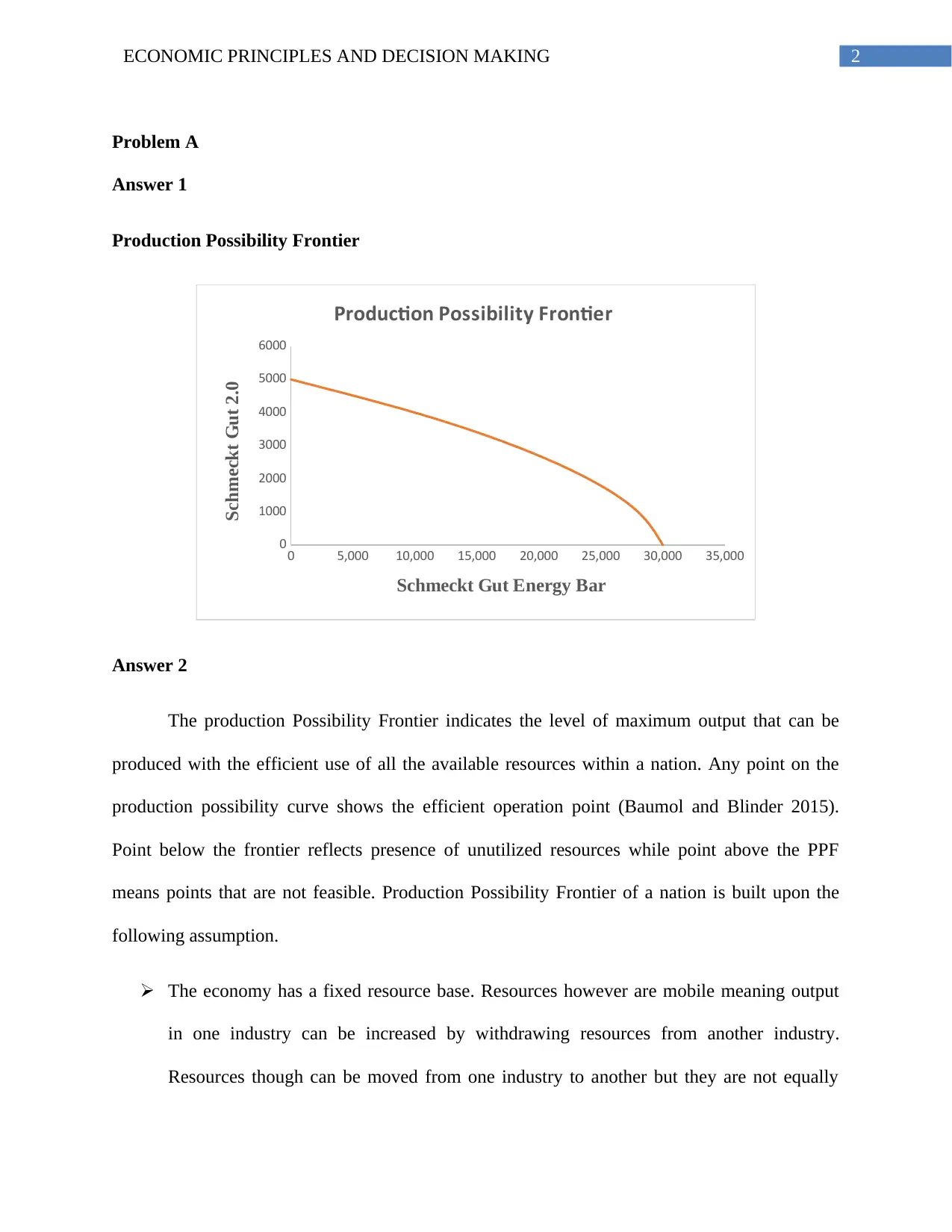
2ECONOMIC PRINCIPLES AND DECISION MAKING
Problem A
Answer 1
Production Possibility Frontier
0 5,000 10,000 15,000 20,000 25,000 30,000 35,000
0
1000
2000
3000
4000
5000
6000
Production Possibility Frontier
Schmeckt Gut Energy Bar
Schmeckt Gut 2.0
Answer 2
The production Possibility Frontier indicates the level of maximum output that can be
produced with the efficient use of all the available resources within a nation. Any point on the
production possibility curve shows the efficient operation point (Baumol and Blinder 2015).
Point below the frontier reflects presence of unutilized resources while point above the PPF
means points that are not feasible. Production Possibility Frontier of a nation is built upon the
following assumption.
The economy has a fixed resource base. Resources however are mobile meaning output
in one industry can be increased by withdrawing resources from another industry.
Resources though can be moved from one industry to another but they are not equally
Problem A
Answer 1
Production Possibility Frontier
0 5,000 10,000 15,000 20,000 25,000 30,000 35,000
0
1000
2000
3000
4000
5000
6000
Production Possibility Frontier
Schmeckt Gut Energy Bar
Schmeckt Gut 2.0
Answer 2
The production Possibility Frontier indicates the level of maximum output that can be
produced with the efficient use of all the available resources within a nation. Any point on the
production possibility curve shows the efficient operation point (Baumol and Blinder 2015).
Point below the frontier reflects presence of unutilized resources while point above the PPF
means points that are not feasible. Production Possibility Frontier of a nation is built upon the
following assumption.
The economy has a fixed resource base. Resources however are mobile meaning output
in one industry can be increased by withdrawing resources from another industry.
Resources though can be moved from one industry to another but they are not equally
⊘ This is a preview!⊘
Do you want full access?
Subscribe today to unlock all pages.

Trusted by 1+ million students worldwide
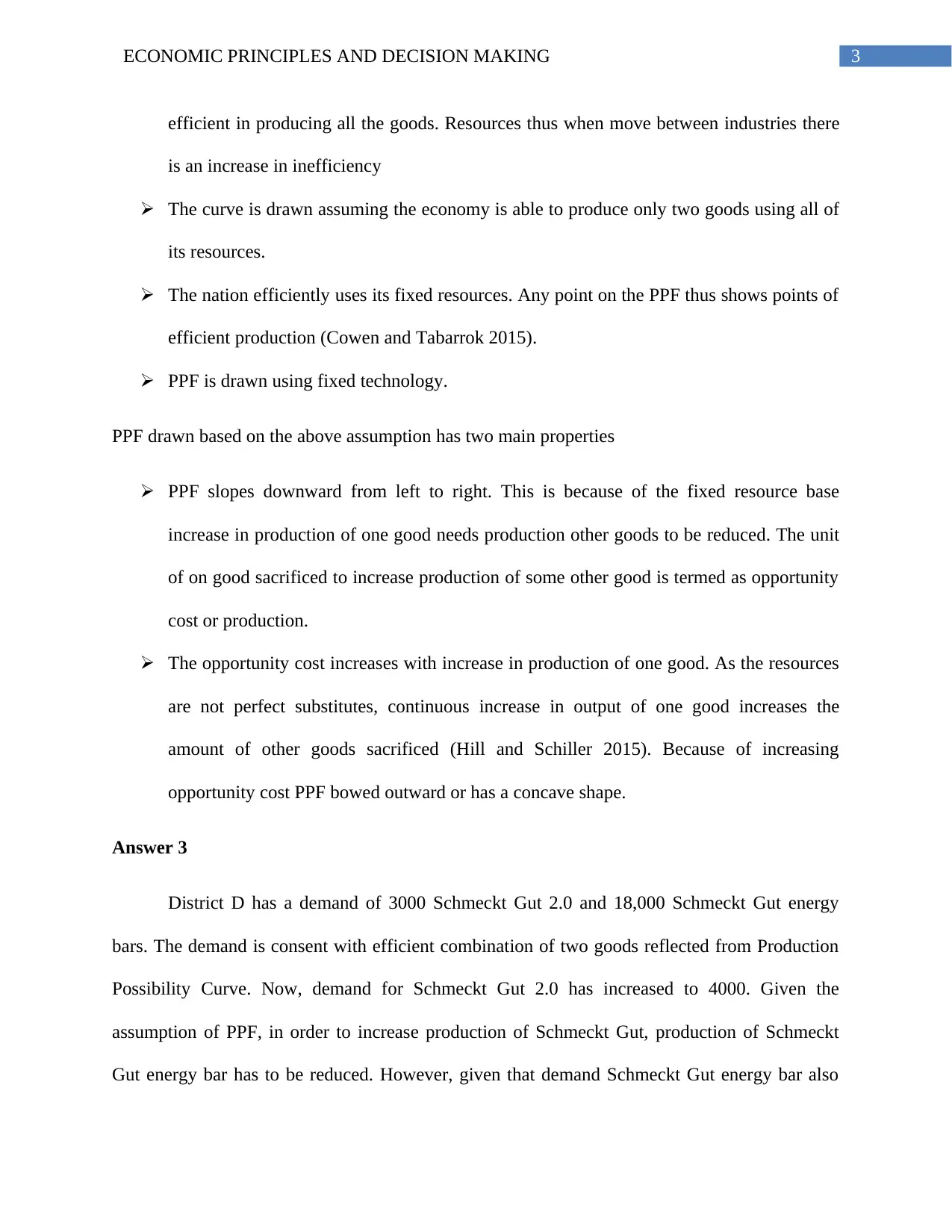
3ECONOMIC PRINCIPLES AND DECISION MAKING
efficient in producing all the goods. Resources thus when move between industries there
is an increase in inefficiency
The curve is drawn assuming the economy is able to produce only two goods using all of
its resources.
The nation efficiently uses its fixed resources. Any point on the PPF thus shows points of
efficient production (Cowen and Tabarrok 2015).
PPF is drawn using fixed technology.
PPF drawn based on the above assumption has two main properties
PPF slopes downward from left to right. This is because of the fixed resource base
increase in production of one good needs production other goods to be reduced. The unit
of on good sacrificed to increase production of some other good is termed as opportunity
cost or production.
The opportunity cost increases with increase in production of one good. As the resources
are not perfect substitutes, continuous increase in output of one good increases the
amount of other goods sacrificed (Hill and Schiller 2015). Because of increasing
opportunity cost PPF bowed outward or has a concave shape.
Answer 3
District D has a demand of 3000 Schmeckt Gut 2.0 and 18,000 Schmeckt Gut energy
bars. The demand is consent with efficient combination of two goods reflected from Production
Possibility Curve. Now, demand for Schmeckt Gut 2.0 has increased to 4000. Given the
assumption of PPF, in order to increase production of Schmeckt Gut, production of Schmeckt
Gut energy bar has to be reduced. However, given that demand Schmeckt Gut energy bar also
efficient in producing all the goods. Resources thus when move between industries there
is an increase in inefficiency
The curve is drawn assuming the economy is able to produce only two goods using all of
its resources.
The nation efficiently uses its fixed resources. Any point on the PPF thus shows points of
efficient production (Cowen and Tabarrok 2015).
PPF is drawn using fixed technology.
PPF drawn based on the above assumption has two main properties
PPF slopes downward from left to right. This is because of the fixed resource base
increase in production of one good needs production other goods to be reduced. The unit
of on good sacrificed to increase production of some other good is termed as opportunity
cost or production.
The opportunity cost increases with increase in production of one good. As the resources
are not perfect substitutes, continuous increase in output of one good increases the
amount of other goods sacrificed (Hill and Schiller 2015). Because of increasing
opportunity cost PPF bowed outward or has a concave shape.
Answer 3
District D has a demand of 3000 Schmeckt Gut 2.0 and 18,000 Schmeckt Gut energy
bars. The demand is consent with efficient combination of two goods reflected from Production
Possibility Curve. Now, demand for Schmeckt Gut 2.0 has increased to 4000. Given the
assumption of PPF, in order to increase production of Schmeckt Gut, production of Schmeckt
Gut energy bar has to be reduced. However, given that demand Schmeckt Gut energy bar also
Paraphrase This Document
Need a fresh take? Get an instant paraphrase of this document with our AI Paraphraser
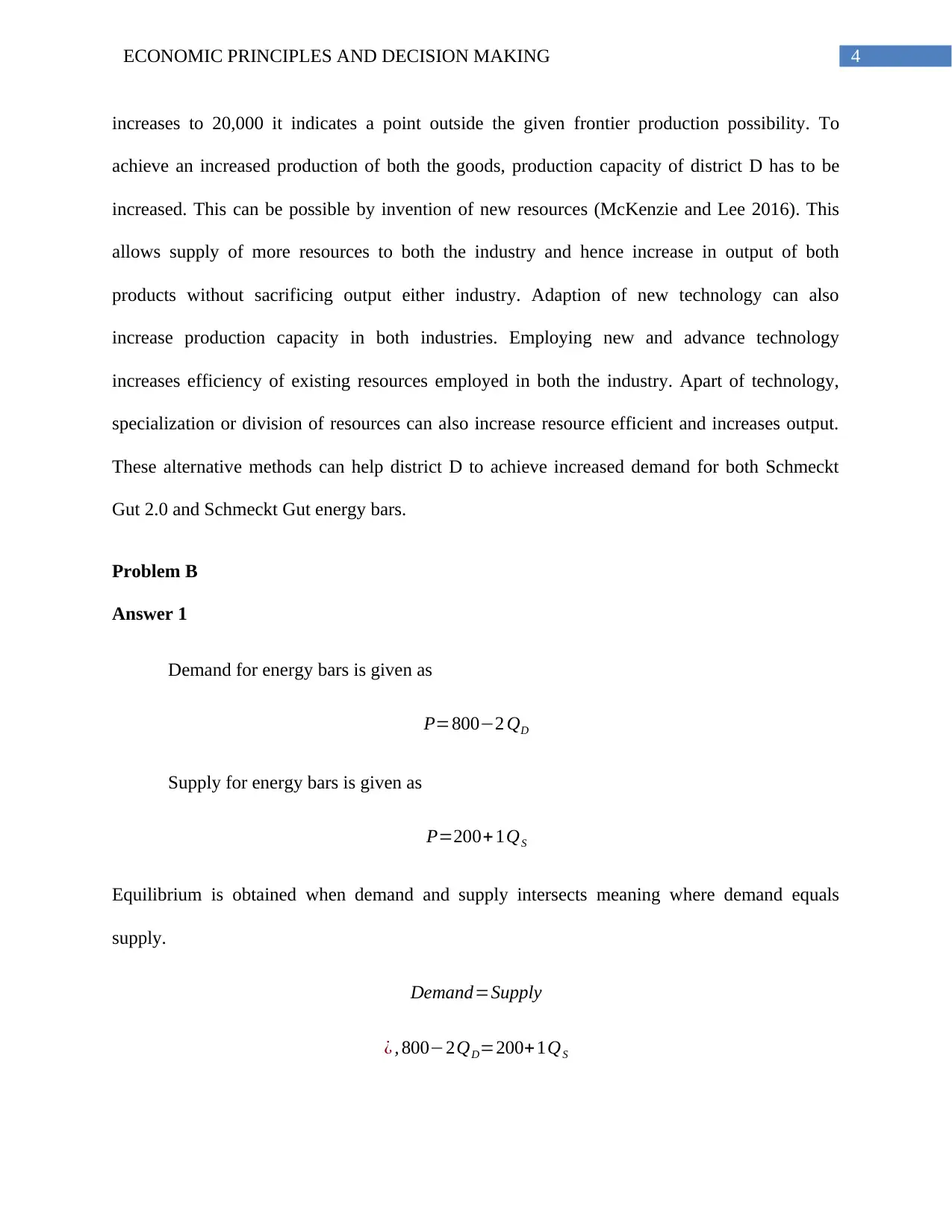
4ECONOMIC PRINCIPLES AND DECISION MAKING
increases to 20,000 it indicates a point outside the given frontier production possibility. To
achieve an increased production of both the goods, production capacity of district D has to be
increased. This can be possible by invention of new resources (McKenzie and Lee 2016). This
allows supply of more resources to both the industry and hence increase in output of both
products without sacrificing output either industry. Adaption of new technology can also
increase production capacity in both industries. Employing new and advance technology
increases efficiency of existing resources employed in both the industry. Apart of technology,
specialization or division of resources can also increase resource efficient and increases output.
These alternative methods can help district D to achieve increased demand for both Schmeckt
Gut 2.0 and Schmeckt Gut energy bars.
Problem B
Answer 1
Demand for energy bars is given as
P=800−2 QD
Supply for energy bars is given as
P=200+ 1QS
Equilibrium is obtained when demand and supply intersects meaning where demand equals
supply.
Demand=Supply
¿ , 800−2QD=200+1QS
increases to 20,000 it indicates a point outside the given frontier production possibility. To
achieve an increased production of both the goods, production capacity of district D has to be
increased. This can be possible by invention of new resources (McKenzie and Lee 2016). This
allows supply of more resources to both the industry and hence increase in output of both
products without sacrificing output either industry. Adaption of new technology can also
increase production capacity in both industries. Employing new and advance technology
increases efficiency of existing resources employed in both the industry. Apart of technology,
specialization or division of resources can also increase resource efficient and increases output.
These alternative methods can help district D to achieve increased demand for both Schmeckt
Gut 2.0 and Schmeckt Gut energy bars.
Problem B
Answer 1
Demand for energy bars is given as
P=800−2 QD
Supply for energy bars is given as
P=200+ 1QS
Equilibrium is obtained when demand and supply intersects meaning where demand equals
supply.
Demand=Supply
¿ , 800−2QD=200+1QS

5ECONOMIC PRINCIPLES AND DECISION MAKING
¿ , 2Q+1 Q=800−200 [ At EquilibriumQD=QS =Q ]
¿ , 3 Q=600
¿ , Q= 600
3
¿ , Q=200
Putting the value of equilibrium quantity in either demand or supply function, equilibrium price
can be obtained.
P=800−2 QD
¿ 800− ( 2× 200 )
¿ 800−400
¿ 400
Therefore, market equilibrium price is 400 and that of equilibrium quantity is 200.
Answer 2
If price increased by $1, then price will be (400 +1) = $401.
At this price, corresponding demand and supply can be obtained from the inverse demand and
supply function.
Inverse demand function
P=800−2 QD
¿ , 2QD =800−P
¿ , 2Q+1 Q=800−200 [ At EquilibriumQD=QS =Q ]
¿ , 3 Q=600
¿ , Q= 600
3
¿ , Q=200
Putting the value of equilibrium quantity in either demand or supply function, equilibrium price
can be obtained.
P=800−2 QD
¿ 800− ( 2× 200 )
¿ 800−400
¿ 400
Therefore, market equilibrium price is 400 and that of equilibrium quantity is 200.
Answer 2
If price increased by $1, then price will be (400 +1) = $401.
At this price, corresponding demand and supply can be obtained from the inverse demand and
supply function.
Inverse demand function
P=800−2 QD
¿ , 2QD =800−P
⊘ This is a preview!⊘
Do you want full access?
Subscribe today to unlock all pages.

Trusted by 1+ million students worldwide
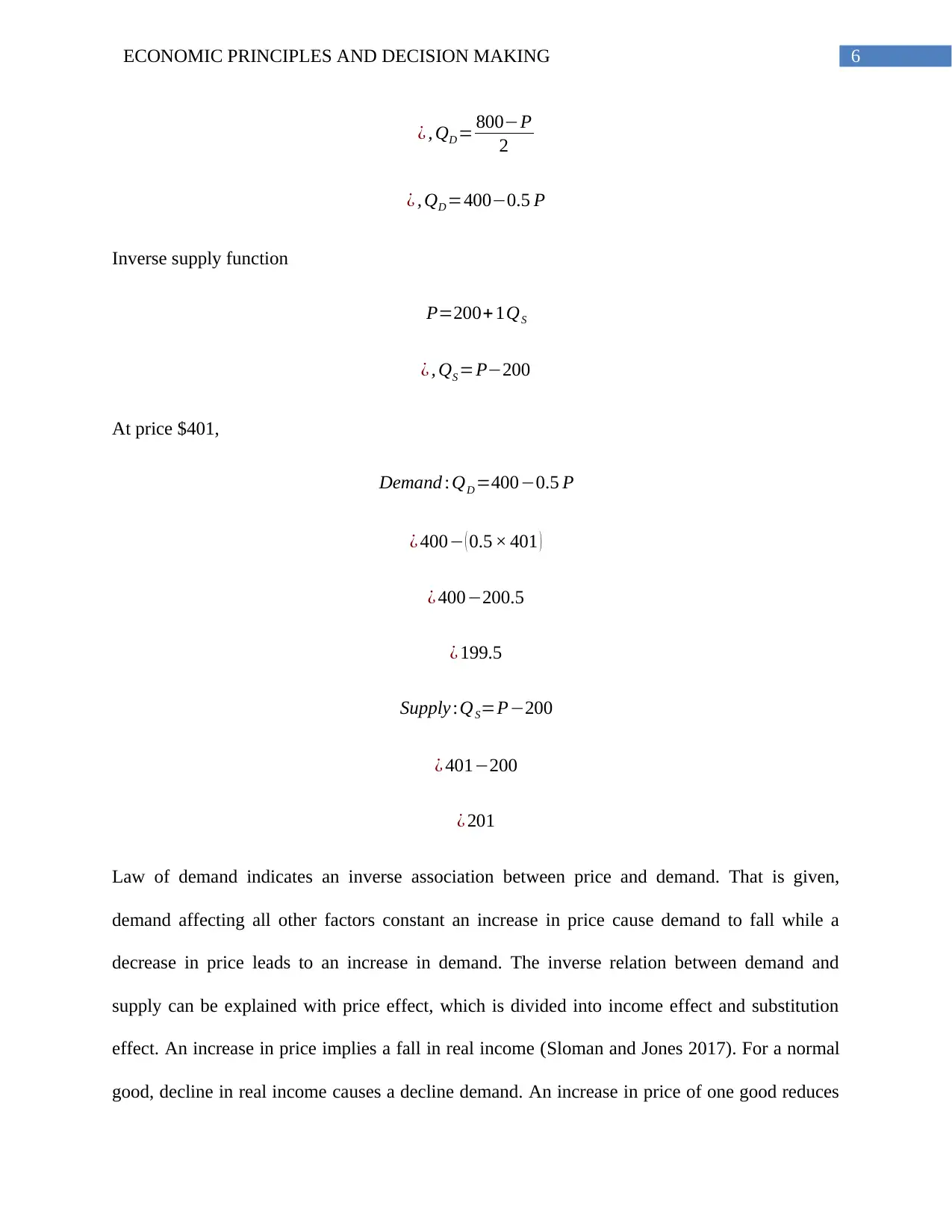
6ECONOMIC PRINCIPLES AND DECISION MAKING
¿ , QD = 800−P
2
¿ , QD =400−0.5 P
Inverse supply function
P=200+ 1QS
¿ , QS =P−200
At price $401,
Demand : QD =400−0.5 P
¿ 400− ( 0.5 × 401 )
¿ 400−200.5
¿ 199.5
Supply :QS=P−200
¿ 401−200
¿ 201
Law of demand indicates an inverse association between price and demand. That is given,
demand affecting all other factors constant an increase in price cause demand to fall while a
decrease in price leads to an increase in demand. The inverse relation between demand and
supply can be explained with price effect, which is divided into income effect and substitution
effect. An increase in price implies a fall in real income (Sloman and Jones 2017). For a normal
good, decline in real income causes a decline demand. An increase in price of one good reduces
¿ , QD = 800−P
2
¿ , QD =400−0.5 P
Inverse supply function
P=200+ 1QS
¿ , QS =P−200
At price $401,
Demand : QD =400−0.5 P
¿ 400− ( 0.5 × 401 )
¿ 400−200.5
¿ 199.5
Supply :QS=P−200
¿ 401−200
¿ 201
Law of demand indicates an inverse association between price and demand. That is given,
demand affecting all other factors constant an increase in price cause demand to fall while a
decrease in price leads to an increase in demand. The inverse relation between demand and
supply can be explained with price effect, which is divided into income effect and substitution
effect. An increase in price implies a fall in real income (Sloman and Jones 2017). For a normal
good, decline in real income causes a decline demand. An increase in price of one good reduces
Paraphrase This Document
Need a fresh take? Get an instant paraphrase of this document with our AI Paraphraser
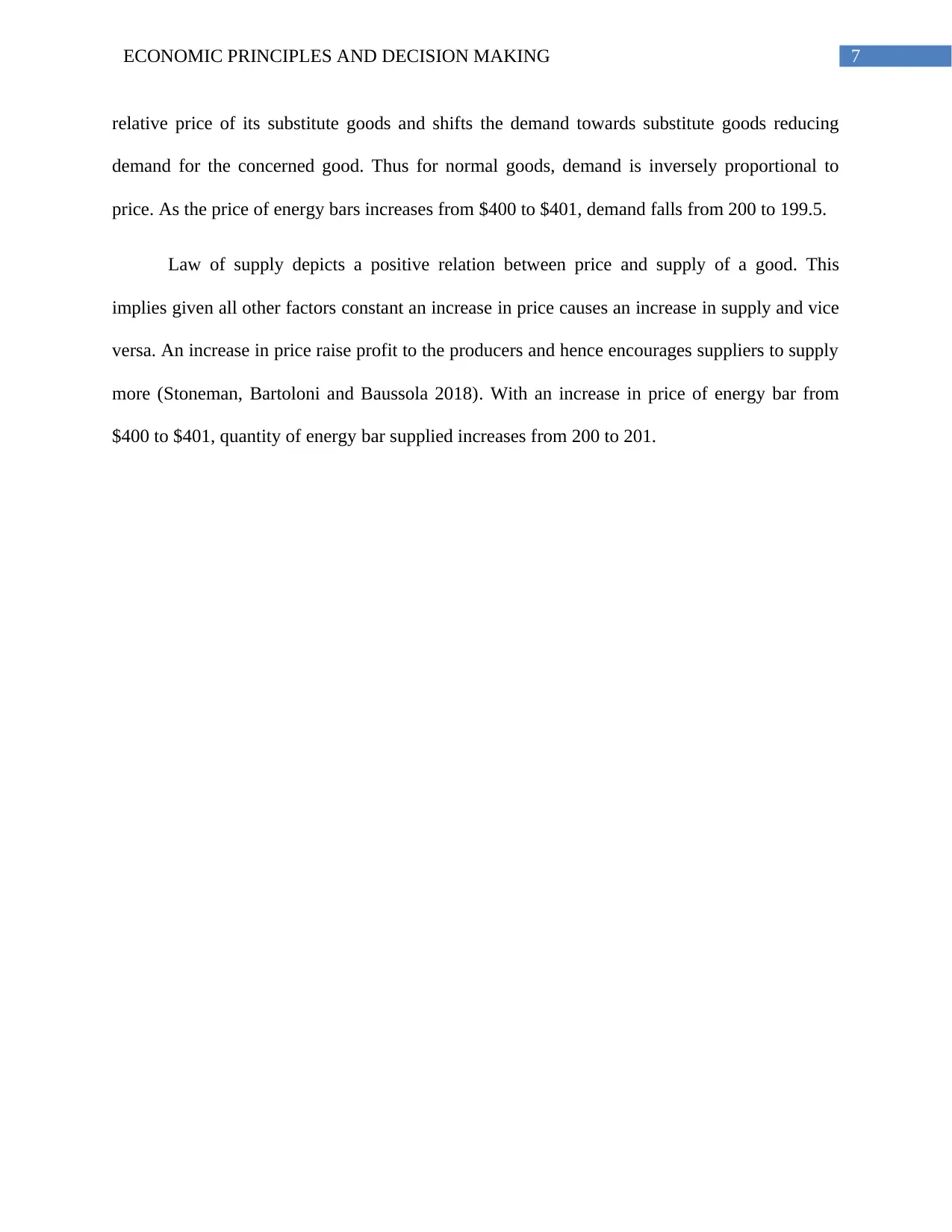
7ECONOMIC PRINCIPLES AND DECISION MAKING
relative price of its substitute goods and shifts the demand towards substitute goods reducing
demand for the concerned good. Thus for normal goods, demand is inversely proportional to
price. As the price of energy bars increases from $400 to $401, demand falls from 200 to 199.5.
Law of supply depicts a positive relation between price and supply of a good. This
implies given all other factors constant an increase in price causes an increase in supply and vice
versa. An increase in price raise profit to the producers and hence encourages suppliers to supply
more (Stoneman, Bartoloni and Baussola 2018). With an increase in price of energy bar from
$400 to $401, quantity of energy bar supplied increases from 200 to 201.
relative price of its substitute goods and shifts the demand towards substitute goods reducing
demand for the concerned good. Thus for normal goods, demand is inversely proportional to
price. As the price of energy bars increases from $400 to $401, demand falls from 200 to 199.5.
Law of supply depicts a positive relation between price and supply of a good. This
implies given all other factors constant an increase in price causes an increase in supply and vice
versa. An increase in price raise profit to the producers and hence encourages suppliers to supply
more (Stoneman, Bartoloni and Baussola 2018). With an increase in price of energy bar from
$400 to $401, quantity of energy bar supplied increases from 200 to 201.
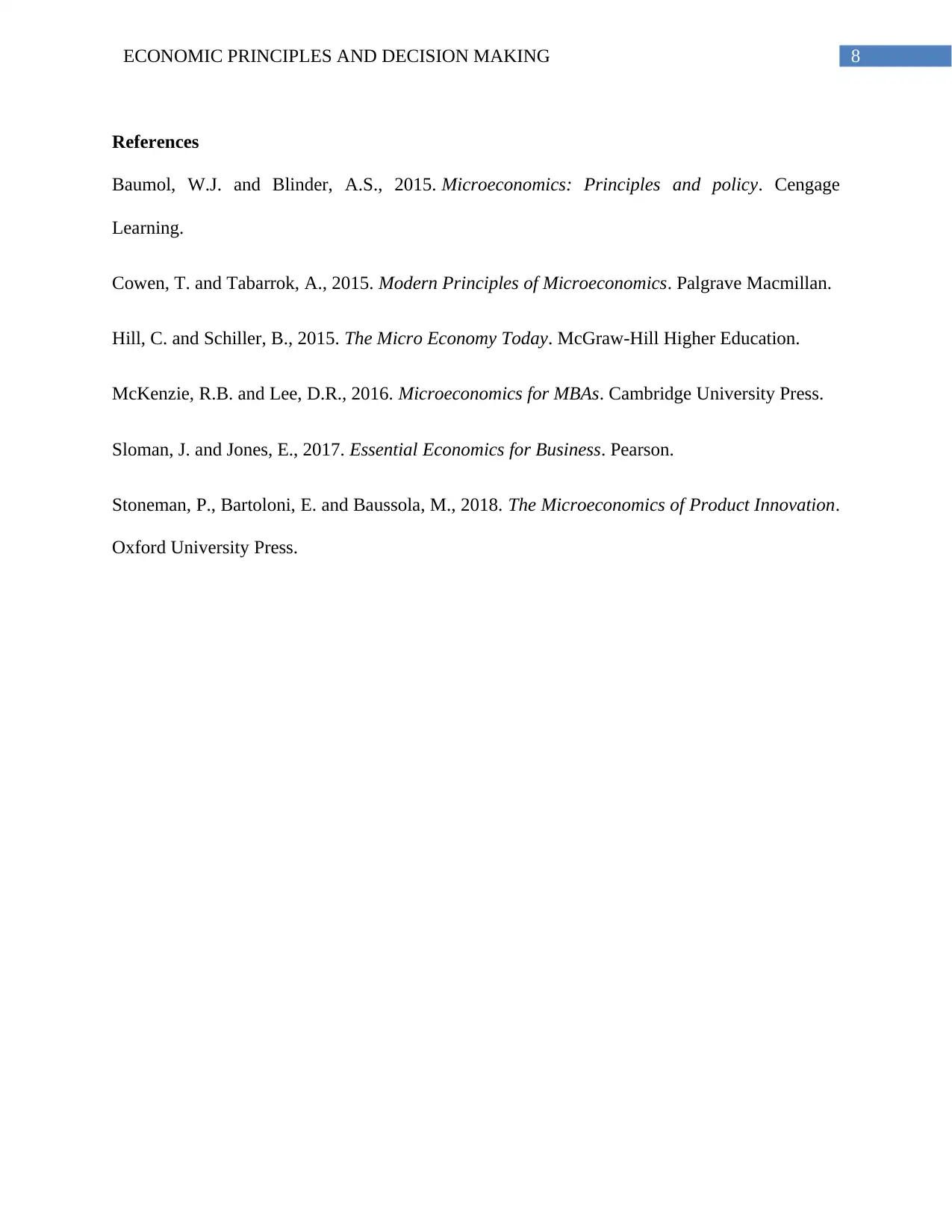
8ECONOMIC PRINCIPLES AND DECISION MAKING
References
Baumol, W.J. and Blinder, A.S., 2015. Microeconomics: Principles and policy. Cengage
Learning.
Cowen, T. and Tabarrok, A., 2015. Modern Principles of Microeconomics. Palgrave Macmillan.
Hill, C. and Schiller, B., 2015. The Micro Economy Today. McGraw-Hill Higher Education.
McKenzie, R.B. and Lee, D.R., 2016. Microeconomics for MBAs. Cambridge University Press.
Sloman, J. and Jones, E., 2017. Essential Economics for Business. Pearson.
Stoneman, P., Bartoloni, E. and Baussola, M., 2018. The Microeconomics of Product Innovation.
Oxford University Press.
References
Baumol, W.J. and Blinder, A.S., 2015. Microeconomics: Principles and policy. Cengage
Learning.
Cowen, T. and Tabarrok, A., 2015. Modern Principles of Microeconomics. Palgrave Macmillan.
Hill, C. and Schiller, B., 2015. The Micro Economy Today. McGraw-Hill Higher Education.
McKenzie, R.B. and Lee, D.R., 2016. Microeconomics for MBAs. Cambridge University Press.
Sloman, J. and Jones, E., 2017. Essential Economics for Business. Pearson.
Stoneman, P., Bartoloni, E. and Baussola, M., 2018. The Microeconomics of Product Innovation.
Oxford University Press.
⊘ This is a preview!⊘
Do you want full access?
Subscribe today to unlock all pages.

Trusted by 1+ million students worldwide
1 out of 9
Related Documents
Your All-in-One AI-Powered Toolkit for Academic Success.
+13062052269
info@desklib.com
Available 24*7 on WhatsApp / Email
![[object Object]](/_next/static/media/star-bottom.7253800d.svg)
Unlock your academic potential
Copyright © 2020–2025 A2Z Services. All Rights Reserved. Developed and managed by ZUCOL.




